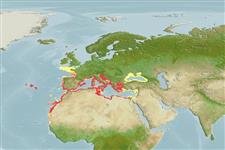Environment: milieu / climate zone / depth range / distribution range
Ecologia
marinhas demersal; intervalo de profundidade 5 - 150 m (Ref. 27000), usually ? - 30 m (Ref. 91154). Subtropical; 50°N - 16°N, 32°W - 42°E
Eastern Atlantic: Bay of Biscay to Mauritania (Ref. 5377), including the Canary, and Azores. Also from the Mediterranean and the Black Sea.
Length at first maturity / Tamanho / Peso / Idade
Maturity: Lm 17.3, range 16 - ? cm
Max length : 36.0 cm SL macho/indeterminado; (Ref. 5506); common length : 25.0 cm SL macho/indeterminado; (Ref. 5506); Idade máx. registada: 16 anos (Ref. 91154)
Found on rocky bottom and on Posidonia beds. Feed on fishes and crustaceans (Ref. 5506). Also found in muddy and algal or seagrass overgrown substrates. Reported to be a simultaneous hermaphrodite, which tends to spawn from early spring to early summer (Ref. 91154).
Tortonese, E., 1986. Serranidae. p. 780-792. In P.J.P. Whitehead, M.-L. Bauchot, J.-C. Hureau, J. Nielsen and E. Tortonese (eds.) Fishes of the north-eastern Atlantic and the Mediterranean. UNESCO, Paris. vol. 2. (Ref. 5506)
Categoria na Lista Vermelha da IUCN (Ref. 130435: Version 2024-2)
Ameaça para o homem
Harmless
Utilização humana
Pescarias: pouco comercial; peixe desportivo: sim
Ferramentas
Relatórios especiais
Descarregue XML
Fontes da internet
Estimates based on models
Preferred temperature (Ref.
123201): 15.1 - 21, mean 18.4 °C (based on 72 cells).
Phylogenetic diversity index (Ref.
82804): PD
50 = 0.5000 [Uniqueness, from 0.5 = low to 2.0 = high].
Bayesian length-weight: a=0.00977 (0.00830 - 0.01151), b=3.04 (3.00 - 3.08), in cm total length, based on LWR estimates for this species (Ref.
93245).
Nível Trófico (Ref.
69278): 3.8 ±0.3 se; based on diet studies.
Resiliência (Ref.
120179): Médio, tempo mínimo de duplicação da população 1,4 - 4,4 anos (K=0.22-0.24).
Fishing Vulnerability (Ref.
59153): Moderate vulnerability (44 of 100).
Nutrients (Ref.
124155): Calcium = 75.5 [30.7, 150.6] mg/100g; Iron = 0.921 [0.503, 1.748] mg/100g; Protein = 18.3 [16.5, 20.0] %; Omega3 = 0.4 [0.3, 0.7] g/100g; Selenium = 26.7 [14.2, 51.5] μg/100g; VitaminA = 19.7 [6.4, 69.4] μg/100g; Zinc = 0.772 [0.552, 1.131] mg/100g (wet weight);
